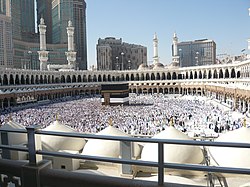
Back Hijaz ACE الحجاز Arabic الحجاز ARZ Hiyaz AST Hicaz Azerbaijani حجاز AZB Хижәз Bashkir Хіджаз Byelorussian Хиджаз Bulgarian হেজাজ Bengali/Bangla
Hejaz
Al-Ḥijāz (ٱلْحِجَاز) Hijaz | |
|---|---|
Region | |
 Islam's holiest site, that is Al-Masjid al-Haram, which surrounds the Kaaba (middle), in Mecca. Mecca is the city of Muhammad's birth and ancestry, and an annual point of pilgrimage for millions of Muslims. | |
 | |
| Coordinates: 23°N 40°E / 23°N 40°E | |
| Country | |
| Regions | Al-Bahah, Mecca, Medina, Tabuk |
The Hejaz (/hiːˈdʒæz, hɪˈ-/, also US: /hɛˈ-/; Arabic: ٱلْحِجَاز, romanized: al-Ḥijāz, lit. 'the Barrier', Hejazi Arabic pronunciation: [alħɪˈdʒaːz]) is a region that includes the majority of the west coast of Saudi Arabia, covering the cities of Mecca, Medina, Jeddah, Tabuk, Yanbu, Taif and Baljurashi. It is thus known as the Western Province,[1] and it is bordered in the west by the Red Sea, in the north by Jordan, in the east by the Najd, and in the south by the Region of 'Asir.[2] Its largest city is Jeddah, which is the second-largest city in Saudi Arabia, with Mecca and Medina, the holiest Muslim sites and respectively,the fourth- and fifth-largest cities in the country.[3]
As the location of the cities of Mecca[4] and Medina,[5][6][7] respectively the first and second holiest sites in Islam, the Hejaz is significant in the Arabo-Islamic historical and political landscape. This region is the most populated in Saudi Arabia,[8] and Arabic is the predominant language, as in the rest of Saudi Arabia, with Hejazi Arabic being the most widely spoken dialect here. Some Hejazis are of ethnically diverse origins,[3] although the vast majority are of Arab origin.[9]
According to Islamic tradition, this region is the birthplace of the Islamic prophet Muhammad, who was born in Mecca, which is locally considered to have been founded by his ancestors Abraham, Ishmael, and Hagar.[10][11] The area became part of his empire through the early Muslim conquests, and it formed part of successive caliphates, first the Rashidun Caliphate, followed by the Umayyad Caliphate, and finally the Abbasid Caliphate. The Ottoman Empire held partial control over the area; after its dissolution, an independent Kingdom of Hejaz existed briefly in 1925 before being conquered by the neighbouring Sultanate of Nejd, creating the Kingdom of Hejaz and Nejd.[12] In September 1932, the Kingdom of Hejaz and Nejd joined the Saudi dominions of Al-Hasa and Qatif, creating the unified Kingdom of Saudi Arabia.[13][14]
- ^ Mackey, p. 101. "The Western Province, or the Hejaz[...]"
- ^ Hopkins, Daniel J. (2001). Merriam-Webster's Geographical Dictionary. Merriam-Webster. p. 479. ISBN 0-87779-546-0. Retrieved March 17, 2013.
- ^ a b Leatherdale, Clive (1983). Britain and Saudi Arabia, 1925–1939: The Imperial Oasis. Psychology Press. p. 12. ISBN 9780714632209.
- ^ Quran 48:22-29
- ^ Quran 9:25-129
- ^ Quran 33:09-73
- ^ Quran 63:1-11
- ^ "Mecca: Islam's cosmopolitan heart". Archived from the original on December 14, 2018. Retrieved July 8, 2014.
The Hijaz is the largest, most populated, and most culturally and religiously diverse region of Saudi Arabia, in large part because it was the traditional host area of all the pilgrims to Mecca, many of whom settled and intermarried there.
- ^ Minahan, James (1996). Nations Without States: A Historical Dictionary of Contemporary National Movements. Greenwood Press. p. 229. ISBN 978-0-313-28354-3.
- ^ Lings, Martin (1983). Muhammad: His Life Based on the Earliest Sources. Islamic Texts Society. ISBN 978-0-946621-33-0.
- ^ Glassé, Cyril (1991). "Kaaba". The Concise Encyclopedia of Islam. HarperSanFrancisco. ISBN 0-0606-3126-0.
- ^ Yamani, M. (2009), Cradle of Islam: the Hijaz and the quest for an Arabian identity, I.B. Tauris, ISBN 978-1-84511-824-2 (Pbk. ed.)
- ^ Al-Rasheed, M. A History of Saudi Arabia. Cambridge, England, UK: Cambridge University Press, 2002. [verification needed]
- ^ A Brief overview of Hejaz - Hejaz history Archived August 15, 2018, at the Wayback Machine [verification needed]
© MMXXIII Rich X Search. We shall prevail. All rights reserved. Rich X Search